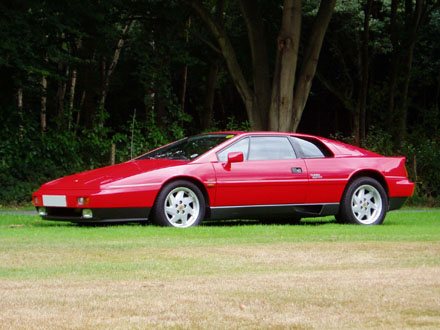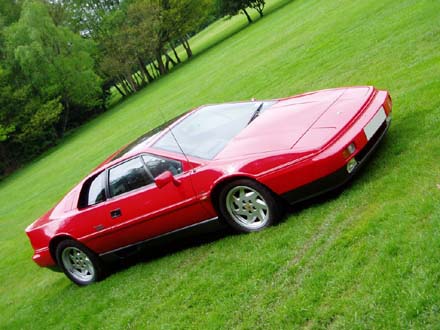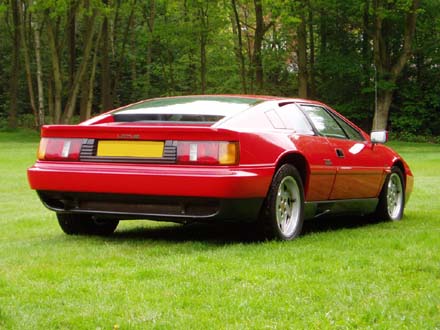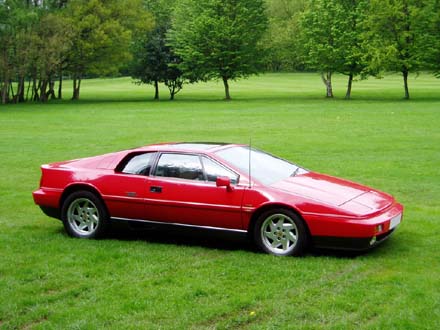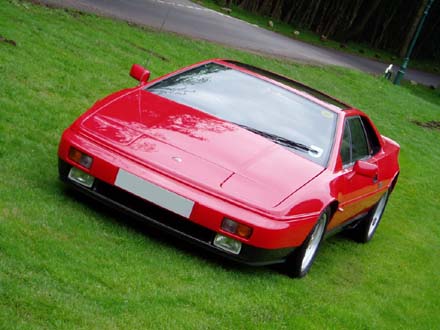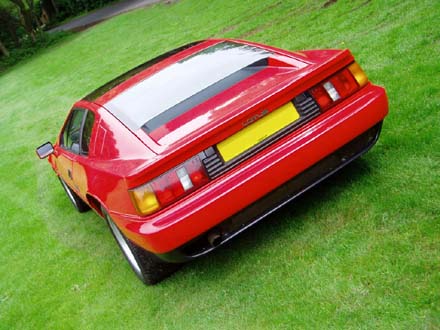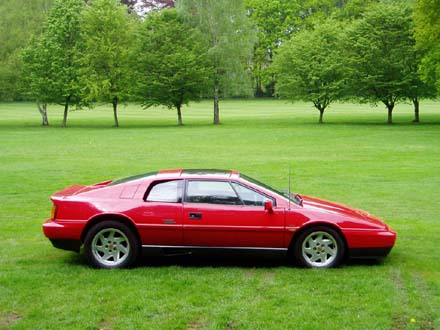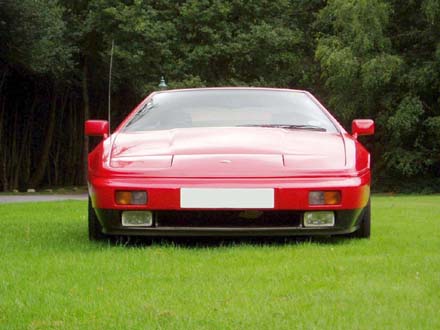
Click on Images to Enlarge
BUYER'S GUIDE
1988 LOTUS ESPRIT TURBO X180
Lotus Esprit's tend to respond well to regular servicing and can be reliable cars. It is important to rectifly an mechanical problems as they occur, otherwise they can cause more problems, which can lead to big bills. Special attention needs to be paid to a number points. Below are a list of things to look out for:
Brakes
Esprits are rarely used every day. This can often cause problems with brakes, leading to sticking calipers, particularly on the pre 1987 Turbo Esprit. After this date, Lotus' deal with Toyota meant Lotus used Toyota calipers on the Esprit. At the same time the inboard discs at the rear of the Turbo Esprit were move outboard, making access to the brake discs better. Handbrakes also seize with lack of use.
Cooling
On the road the temperature gauge should sit between 80 and 90°. Make sure the fans cut in at about 100° when stationary as, like the radiator itself, they're vulnerable to corrosion and neglect. Again, this is where seldom driven cars suffer. Aluminium coolant pipes run the length of the car and at the exposed front end they're starting to rot through, mine did, but they aren't expensive.
Transmission
The Steven’s Lotus Esprit uses a Renault Uni1-16 gearbox. The unit is strong enough, though parts are becoming scarce. Its primary cause of grief is water ingress, ruining the bearings because water that collects on the engine cover runs off directly into the breather. There's little than can be done about this other than avoiding getting it wet and changing the oil regularly. Expect a few oil leaks, particularly from the back, and only worry if they start to get serious. The later gearbox is actually based on that from the Renault Traffic with different ratios. Everything is easily available and they're up to the job. As Esprit's aren't used much, they tend to stand for long periods of time and consequently the driveshaft oil seals often dry out, causing oil leaks. However, the seals aren't expensive to buy and are straight forward to replace.
Body and Chassis
Lotus have never been well renowned for having a long-lasting chassis, but the rot worries of the Lotus Esprit S1 and S2 were silenced in 1981 with the adoption of a galvanised chassis for the Lotus Esprit S2.2. That said, check the chassis tube that runs pass the exhaust manifold on turbocharged cars as the heat from the turbo burns off the coating and the welding repair is an engine out job. This has happened to my Esprit and it was an engine out job to fix. Chassis damage from an accident is not very common. What's more likely is broken chassis to body mounts at the rear, causing a loose feel to the back end. Inexperienced garages often leave out the chassis brace strut that prevents this. Stress cracking of the bodywork is not usually a problem, particularly since Lotus introduced their Vacuum Assisted Resin Injection process in 1987. If cracks are present, previous damage is normally the cause. Repair sections of the body come in quarters, and while the outward appearance will often disguise a repair, look under the spare wheel for a join. As anyone familiar with the Triumph TR7 will know, 1970s British cars with pop-up headlamps can prove problematic. The Lotus Esprit used the TR7 headlamp motors and then can be unreliable. The lamps sit in a casing in the body work and if the drain hole at the bottom of the casing gets block up with leaves, the water won't drain away and will rot the lamps. The electric windows also prove a problem, as rain water filters through the door skin and rots the motor. The window motor was from a Jaguar XJS and can be replaced. This is a good reason the garage an Esprit. Also ensure the windows and window guides are clean, as this will help the motor and allow the glass move smoother.
Suspension
The suspension is why you buy a Lotus Esprit and as such needs to be spot on. Listen for creaking from the rear suspension that's often put down to worn dampers, when it fact the bush has collapsed between the lower arm and the upright. There's a knack to replacement as it's very easy to crack the aluminium upright in the process. If the dampers do feel as if they've had it, budget on £100 a corner. I had creaking in the rear suspension and so had my dampers replaced, which fixed it. Pre 86, Lotus Esprit Turbo's used trunions as the bottom link of the front suspension, just like the 60s Elan. Crucially, these need lubricating with EP80 oil as grease will destroy them. This is despite them being fitted with grease nipples. Latterly, Lotus opted for more reliable ball joints that cost around £15 a piece. Steering rack wear is very common on non power assisted steering cars (Pre 1993 S4 Esprit's), due to the wide front wheels. Steering racks usually last about 3 - 4 years, with regular use.
Engine
The Lotus all-alloy 4 cylinder twin-cam engine can be reliable if properly maintained and should see well over 100,000 miles between engine rebuilds. Cambelts have to be changed every three years or 30k miles, some say even sooner, because failure is terminal for the engine. Oil changes should be every 3000 miles and Mobile 1 15W 50 is a good engine oil to use. As the car's aren't used much (so tend to stand), this can cause the drive shaft seals to dry up, which causes oil leaks. So check for oil puddles under the rear of the car. It's also important is the use of the correct Lotus oil filter that has an anti-drain valve to ensure there's oil at the bearings on start-up. Whether turbocharged or not, listen for bearing rumble and check for 3.5bar at idle. Though a small amount of smoke will be inevitable on older cars, it shouldn't be excessive and don't confuse blue smoke from the exhaust with oil burning off the exhaust manifold from the leaking cam covers. Smoke on start up from a naturally aspirated car will almost definitely be valve guides, whereas from a turbocharged car it is nearly always the turbo's seals. Manifolds often crack, as it is positioned close to the rear tyre and rain water can splash on the hot manifold. Fitting a new manifold can be a problem as the manifold studs connecting it to the engine can be seized, sometimes requiring the head or even the entire engine to be removed. It's difficult to see the entire condition of the manifold without the use of a lift, so listen carefully for chuffing. The biggest killer of turbocharged pre-87 engines is over-boosting. This is a twofold problem caused primarily by the Garrett wastegate seizing through rust and secondly because prior to 1987, the relatively weak cast pistons and iron liners used were already at their strength limit. Even without wastegate seizure the ring lands of the pistons break up, grenading the engine. Add up to 1..5 bar of uncontrolled turbo boost and it's a recipe for disaster. Accelerate hard in second gear and make sure the needle of the boost gauge doesn't exceed half way on the dial. New wastegates aren't available so repair is the only option. Post 87 engines benefit from much tougher forged pistons and Nicasil coated aluminium liners which will take higher than standard boost levels and are a must for a rebuilt engine despite their considerable price. Until 1989, fuelling for both variants was achieved through twin side-draught Dellortos, 40mm in the case of the Turbo and 45mm otherwise. They very rarely need changing other than when the mixture screw has corroded solid into the housing.
Generally it's worth warming up the Lotus Esprit engine for 2 minutes before you set off and 2 minutes before you turn the engine off. This allows oil into the Turbo and preserves the life of the engine. Also it's a good idea to use the car regularly, as this will keep the components working.
Looked after properly, the Lotus Esprit 910 engine is a reliable and powerful unit, however, if treated with indifference it can be trouble. Always a fairly harsh engine, you should hear a small amount of top end camshaft noise but nothing else. Oil pressure should be around 80lbs when cold at 2,000rpm, and about 60lbs when hot. Listen for deep rattles when the engine is blipped and at 3000rpm on a very light throttle which indicates worn big ends, a deep rumble which indicates worn main bearings. Finally, when the engine is warm check for blue-grey exhaust smoke which means worn piston rings or valve guides. Early 2.2 litre cars had a habit of seizing the rear main bearing due to poor oil feed, but this should have been sorted out long ago. With the engine warm, remove the oil filler cap with the engine idling. There should be no more than a light breeze of oil vapour coming out; puffing grey fumes indicate a well worn engine. Equally important is the engine oil; make sure that is super clean and with no traces of water. Check the condition of the coolant, as this needs to be clean blue or green antifreeze and with no traces of oil and this needs changing annually.
Interior
The Lotus Esprit's interior is a futuristic place to be. Originally designed by Giugario back in 1972, the revised Steven's interor had some subtle updates, but it's more or less the same inside. Electrically they fare better than reputation would have you believe with bad earths being a usual culprits. But the trim doesn't wair well. The leather needs feeding with a leather oil once a year to stop it from cracking. Tan coloured leather interours often show cracks and dirt and will need retriming. Lotus offer a full leather retrim for the Esprit.
Click on Image to Enlarge
The information in this article is provided by Esprit Engineering. The car featured is Mark's 1988 Lotus Esprit Turbo X180.
info@lotusespritturbo.com www.lotusespritturbo.com
